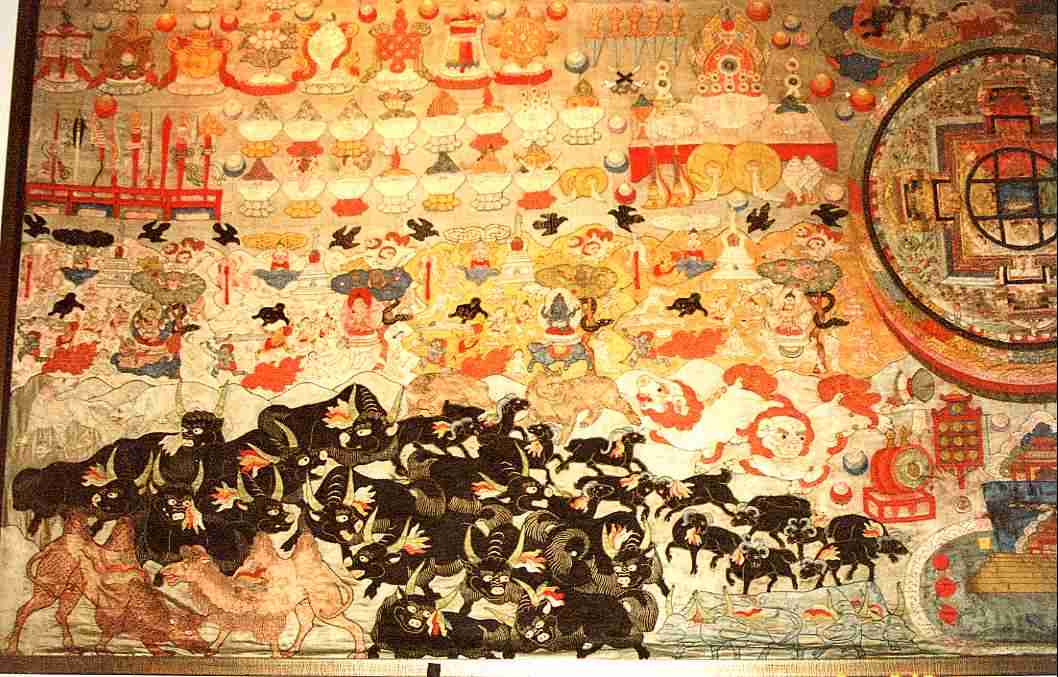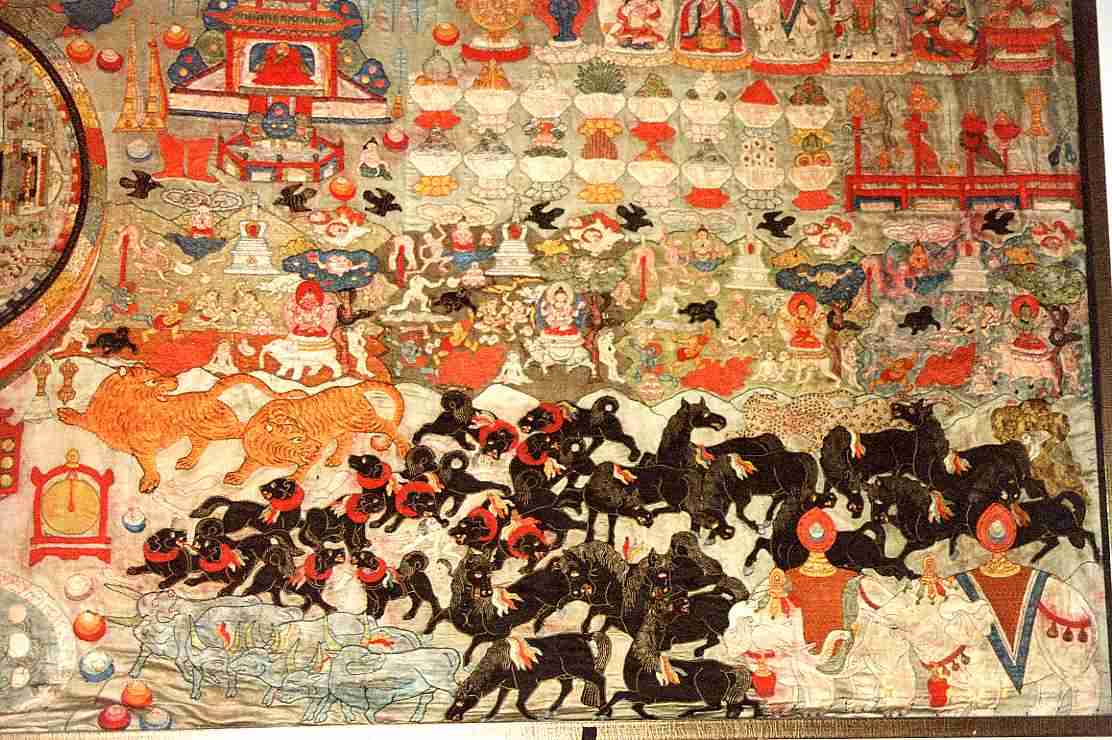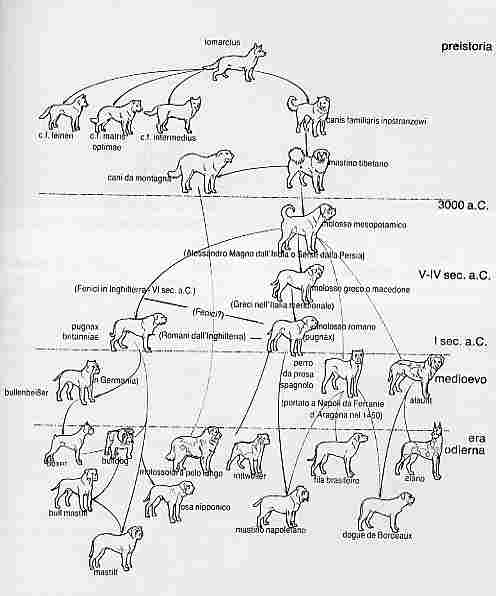|
The theory, the Pyrenees mountain dog -
like all remaining herd protection dogs - descends from the Tibetan herd
protection dog (falsely Tibet Mastiff called), is still now and then
to be read. Them were at the end 19. century spreads, and it is fully
unfolded in Oskar Albrechts work " for the oldest history of the dog.
Studies for the history of its taming, spreading and race arrangement " (Munich
1903), whereby Albrecht already very exactly differentiates between the
Tibetan herd protection dog and the inhabitants Tibets:
So that that Tibet
is certain as output country of our dog, it is not at the same time proven
that the Tibetan people designated in such a way by us (or Tibetans) is its
domesticator (...); if we outgoing from the west linguistically the trace of
the Tibetdogs with the drawidian peoples sitting at the west and south
border of Tibet to stop see, nevertheless probably these peoples would be
applicable for his domestikation also.
Today one makes no longer the trouble of this
intelligent differentiation and identifies themselves the Tibetdog and the
place of its emergence with the place of its current stay.
|
 |
Yak - at the foot of
the mount Chomolungma
(Mount Everest-massiv from Tibetan side) |
With this reduced theory one however
dependent to make on the time of the domestikation of the Yaks,
centralasiatic game cattle, which occurred in the ice age in north Siberia,
during it in the neolithikum still from the Afghan part of the mountains of
Pamir is proven by a rock design, which represents a hunt scene with a Yak.
The dark-brown to black Yak is optimally adapted to the life in 4.000 to
6,000 m height. The body size of this game cattle is remarkable: Yakbulls
reach a height in shoulder from 67 to 83 inches and bodymass from 1474 to
2679 pounds, while the cows become heavy a height of 57 to 63 inches and
only 804 to 938 pounds. The Yak-cows with its calves lives usually together
in large herds, the bulls is rather loners or unites in small groups. During
some researchers the houseyak keep for just as old as the house cattle,
assume others that only admits become from house cattle in inside Asia the
impact the Yakdomestication gave So far oldest vouchers were found in the
Orchon caves in that Mongolia and dated on the 2000 B.C.. Time beginning and
determination of these finds are however doubtful.
|
 |
 |
Yaks, sheep, horses threatened by
bear, tiger, snow leopard protects - In the middle of rhight by Do
Khyi`s
tapestry from a Gönkhang, Tibet
centrically - Lion dogs - stylized |
One imagines domestication in such a way that
young yaks, whose dams were hunted with the hunt were caught and integrated
into the cattle herd One can naturally not completely exclude a taming of
wild yaks, but the bull-combatsimilar scenes on wall paintings ain Catal
Hueyuek let appear a catching and taming of game cattle as a not completely
harmless affair, how Cauvin paints with satisfaction: In order as many more
difficult catching and taming must be adults Yak cows there not to talk
about the enormous bulls at all. So one can assume the Yak probably only
starting from the 2000 B.C. is domesticated, on the southern side of the
Himalaya, because the natural salt occurrences are very small here and by it
the dependence of the young Yak held in shank on humans still faster to be
reached were
|
 |
Here now the second
"mistake" theorie over the ancestor shank of the large Tibetan dog:
The "descending
theory" after Studer,
therefore the Do Khyi it should be master father of all Molossides - and
mastifflike dogs race.
On the basis of modern Kynological criteria these theories not durable
already are around 1870 to 1935 these were already violently disputed.
Therefore these "legends" keep themselves persistent nevertheless are
copied again and again !
|
Now if all other herd protection dogs
should descend from the Tibetan herd protection dog, then the hirten could
have defended good 6,000 years long their sheep -, goat and cattle herds
alone and successfully against booty grip arms. If this had succeeded to
them during this long period for what would have they then still another
herd protection dog required?
Now it would be unfair to make the
existence of the Tibetan herd protection dog dependent only on the Yak it
already well wooled goats protected, before it was bred for the Yak in the
larger variant, but it is proven that goats came first in the triangle North
Iran North Irak Anatolien Syria domesticated and probably only -4000 over
Iran into the Indus valley and to Nepal. Then (somewhat smaller) the
prototype of the Tibetan herd protection dog might probably have come with
the domesticated goats to Nepal and into the Himalaya massif in the broader
sense. This consideration supported of Albrechts linguistic reference that
the baskian name for dog txakurra (speak tchakurra) does not have any
correspondence in indogermanic languages, probably however in Drawidi: In
the languages of those small, absent-minded drawidic people remainders, in
with difficulty accessible mountains and on climatically only them
affirmative highlands to today their existence periods, the baskian meets us
chakurra again. We meet it in the Tamil, Malayalam, Kanaresi and as kukurra,
in nepali bengalian idiom such as Darhi, Denwar, Kocch and in the south
Indian Chensu as kukur, in the Telugu as kukka, whereby it is to be noticed
that this in most of the aforementioned languages at the same time the only,
for the dog at all occurring designation is. Therefore is also (...) in the
oldest arian (i.e. indogermanic; Note: J.M.) language of India, in the
Sanscrit, to regard beside svan and bhasaka still occurring kukurra as
borrowing from the front India. We receive thus to the original indogermanic
svan due to liguistic documents a dog taken by the Indian from the drawidian
primitive culture into the asiatic branch of the indogermanian culture area
kukkura.
If one grasps the circulation area of the
dog designation kukkura, then it turns out that she coincides with the
geographical spreading district of a dog, that the modern cynologists as the
dog of Tibet (Tibethund) responds (Albrecht, 17-18).
The Tibetan
highcountry wuth Transhimalaya and massiv of Himalaya.....
the bright part is the today´s autonomous region Tibet, on the top right
those the highplateau of Amdo & Cham. |
 |
|
|
The drawidian peoples precede indeed it
displacing indoeuroean peoples, and these spatially as temporally, thus in
the literal sense, because them are like the Basques also after the
serologic results and evaluations of Cavalli Sforza among other things.
Aborigines of its region, it are like the Basques from over - 100,000 Cro
Magnon trunks immigrating from Africa to Arabia developed and have
themselves from the total's group moving on the Sinai Anatolien axle
discharged by Anatolien or the north Iraq to the east toward Iran and India,
while the pro ton Basques occupied the southern edge of Europe.
The indogermanian peoples, who are the
Drawiden into inhospitable peripheral areas back urge a part of the entire
indoeuropean spectrum. It mentioned by Albrecht svan group in accordance
with the basic designation for dog. This group covers the southeast
Indogermania, Indian, Iranier, spreads however up to the littauan group, is
in Littaui and in the language of the Origin germanic of people standing
next, European of all, the Letten, receive as well as in the old Prussian,
while with (...) the Origin homeland later leaving Slaves advanced training
of svan any longer does not occur, but but occurs another word (Albrecht,
14).
At the Tibet
theory it is correct with security only that the white herd protection dog
from to fauven in principle or must have developed for black or however
colored dog, by expansion of the white badges. Because the " color " white
is, as I state in 6.2.2.1.6 to attribute to the effectiveness of the
hypostatic alleles of the s-genort: It concerns in reality a dark-colored,
usually black dog, which is inundated by white. The fact that this expansion
the looked for by white over to beaver soloured or outside up to pure white
can reach yellow markings, knows each mountain dog breeder at the latest
from its first litter. From the formerly white badges in the process of the
phylogenetical development a "ground- coloure was reduced " during the
former basic colour (Fauve or black and/or-grey) to few badges
Also because of these genetic factors the
Tibetan herd protection dog cannot come in question as an ancestor gentleman
of all different Herd protection dogs: It is mostly black with tan
badges, with which it is homozygot for the aggressivest rezessive allele of
the A-series and in the best way adapted to the Yak color. Only by a
crossing then still different colors could develop. |
|
Inferred out: Pyrenees
shepherd dogs, volume 1 authors: Josef Mueller, Udo Kopernik, Claudia
Mueller, with friendly permission of Mr. Kopernik, Club Berger of the
Pyrenees (CBP) registered association
Second selection:
Surely the thesis of the Do Khyi is would
be the ancestor of all herd protection dogs as well as that today as
molossoid races designated heavy mastifflike dog races likewise by Dr. Hans
Raeber disproves, yet this theory holds itself which in 19. Century already
violently disputed was also today still persistent, again and again is
copied and reprinted. We should de-mystify the Do Khyi finally and protect
its " treasures " to discover.
We should analyze and discover that the Do
Khyi in its " retreat area ", the Tibetan high country, the remote,
unattainable valleys, for lack of further needs of the " development " in a
high-specialized, inhospitable habitat for humans and animal not required.
It remained us with the Do Khyi a very original dog impact, which probably
already since the beginning of its " propagation " and " use " rather
invariably in natures, behavior and outside appearance us a certification
puts down over living together into for a long time past times, between
humans and dog.
|
![]()